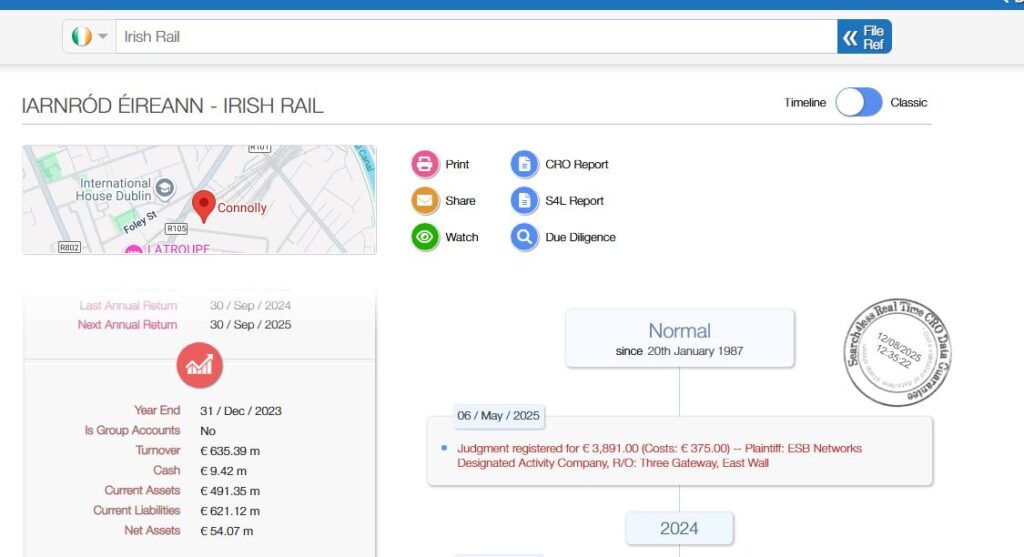The former Dundalk, Newry & Greenore Railway station building in Dundalk is for sale.
Author: ewan.duffy
Dublin Festival of History
The Dublin Festival of History 2025 takes place between 26th September and 11th October 2025. I have reviewed the listing of events and created a page listing those events that are of an IH interest.
Does Irish Rail pay its bills?
There exist service providers that provide access to the records maintained by the Companies Registration Office for a fee (that this data is not available free to the end user is a disgrace, but not surprising in this kakistocracy).
I came upon this entry on the record for Irish Rail:

From my limited legal knowledge, I understand that the Plantiff is the person/entity initiating legal action (the person/entity on the receiving end of a legal action is the defendant).
Northern Ireland Heritage Open Days 2025
Northern Ireland Heritage Open Days is taking place on 13th and 14th September 2025 (some events on Friday 12th).
I have created a listing of events of an IH nature.
Way Down underground
The above titled play, described as “a show featuring music, singing and theatrical performances telling the story of miners’ lives in the coal mines of the Slieveardagh area of Tipperary” is taking place on 29th August 2025 in The Horse and Jockey Hotel’s Derrynaflan Theatre.
Further details, including how to buy tickets, can be found here.
Woodbrook Station
The latest railway station in Ireland has opened. Woodbrook Station on the DART line, between Bray and Shankill, opened on 10th August 2025.
I managed to get out there on the opening day and also nabbed a free ice cream cone (courtesy of Irish Rail or the developer of the adjacent residential development, I don’t know).
I also spotted Irish Rail’s Barry Kenny and CEO Jim Meade in conversation on the concourse outside the station. I did think of saying hello, but I don’t think either gentleman would have wanted their Sunday ruined by having one of their biggest critics identify himself.
Pre-historic miners in Europe
The Smithsonian magazine site has an interesting article about a 3D rendering of 2 female skeletons found in a chert mine* in what is now modern day Czech Republic.
The bones of the skeletons were carbon dated to between 4050 and 4340 B.C.E., making them 6,000 years old.
* Chert was used to make stone tools and weapons
Keeping up with the law
As with most Government entities, Irish Rail tends towards fascism when enforcing laws in their favour whilst not applying a similar standard to rules that apply to them (I’d cite the closure of Dunleer station in 1985 without the requisite 2 months notice required by law, but on a technicality, that would fail as it was CIE that did that – Irish Rail only came into existence in 1987).
I recently commented on the report by the RAIU on track access by passengers at Navan Road Parkway. One of the points raised in this report was that information posters which could have allowed imprisoned passengers to contact Irish Rail, contained a phone number which was no longer in use.
I spotted the information poster below on a train recently and checked out what EC Regulation 1371 states. According to the eur.lex.europa.eu site, this regulation was repealed in 2023, stating:
“No longer in force, Date of end of validity: 06/06/2023; Repealed by 32021R0782“

Makes you wonder what other misinformation about the law is put out.
Pretty in pink
Over the decades of taking photos of Ireland’s railway built heritage, I noticed that different periods see station buildings and other paintable structures in one particular colour across the network, which would suggest that Irish Rail buy their paint in bulk.
Looking back across my archive (over 15,000 railway images), there was a period where yellow was the norm and another where grey took over.
Passing through the walkway in Connolly Station from Amiens Street to the IFSC, I noticed a section of the wall painted in pink. Any bets on pink station buildings in the second half of this decade?

Heritage Week 2025
I decided to leave compiling the Heritage Week listing until later this year, rather than having to do multiple reviews of the listings. The list of IH related events in Heritage Week is now online here.
There is a significant reduction in the number of IH related events this year, compared to previous years, which is regrettable.